For many projects, dedicating an entire PC to a project is overkill. This is where single-board computers come in handy.
The best know SBC is, without a doubt, the Raspberry Pi. It’s known the world over for its versatility, low power consumption, reliability, and ease of use. But there are a number of alternatives to the Raspberry Pi available that can be used to bring their own uniqueness to a project, whether you want more performance, AI, VR support, or a board that is rated for industrial use.
Or maybe you want something smaller than the Raspberry Pi!
Let’s take a look.
ASUS Tinker Board S R2.0
Best Raspberry Pi Alternative: Top SBC overall
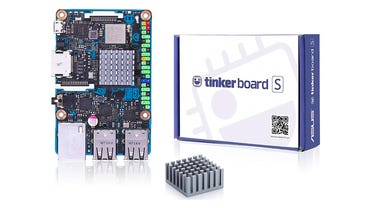 Tech specs:
Tech specs:
- Rockchip Quad-Core RK3288 1.8GHz processor
- Arm Mali-T764 GPU
- 2GB LPDDR3 dual-channel
- 16GB eMMC
- 802.11 b/g/n, Bluetooth V4.0 + EDR
This board has a number of nice touches that make it great for hobbyists. I particularly like the color-coded GPIO header, which makes it easy to recognize respective pin headers. I also like the detailed silk-screen print on the face of the board that makes it clear where everything goes.
Pros:
- Color-coded GPIO for ease of use
- Packed with features
- Great finish
Cons:
- Pricy
Libre Computer Board AML-S905X-CC (Le Potato)
Best cheap SBC that’s still capable: Great set of features
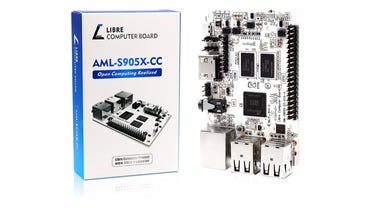
Tech specs:
- Amlogic S905X SoC
- Mali-450 GPU
- Up to 2GB DDR3 SDRAM
- 4x USB 2.0 Type A
- 100Mb Fast Ethernet
- HDMI 2.0
- MicroSD Card Slot
- eMMC Interface
A good SBC at a price that won’t break the bank. You’re not going to be breaking any speed records, but this board does offer a great set of features.
Pros:
- Great price
- Solid performer
- Well made with great documentation
Cons:
- Budget performance
Odroid N2+
Best for those who want power: Offered in a range of options
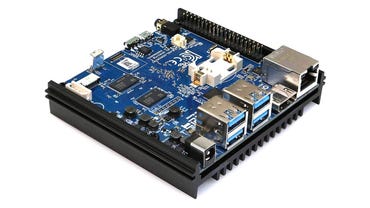 Tech specs:
Tech specs:
- Amlogic S922X — 4x Cortex-A73 @ 2.2GHz, 2x Cortex-A53 @ 1.9GHz
- Mali-G52 GPU
- 2GB or 4GB DDR4
- eMMC socket with optional 8GB to 128GB
- 8MB SPI flash with boot select switch and Petitboot app
- Gigabit Ethernet port
- HDMI 2.1 port for up to 4K@60Hz
- 4x USB 3.0 ports
Powerful but yet energy-efficient, this would be my choice if I wanted to replace a desktop computer with an SBC. This board can run various flavors of Linux, including the latest Ubuntu, as well as the flexibility to run Android.
Pros:
- Lots of different hardware options
- More power than your regular SBC
- Advanced options such as Petitboot
Cons:
- Price
- More complicated than a regular SBC
UDOO BOLT V3
Best for those who want speed: Great for use in VR, AR, and AI projects
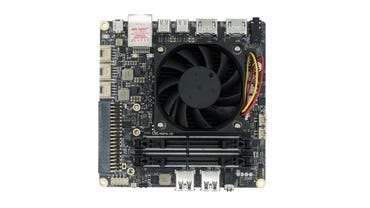
Tech specs:
- AMD Ryzen Embedded V1202b dual core/quad thread @ 2.3ghz (3.2ghz Boost)
- AMD Radeon Vega 3 graphics
- 2x DDR4 dual-channel 64-bit SO-DIMM Sockets With ECC Support up to 32GB
- 32GB eMMC 5.0 High Speed Drive
There’s not much that the UDOO BOLT V3 can’t handle, being almost twice as fast as the 13-inch Intel MacBook Pro , and has been designed with VR, AR, and AI projects in mind. But at $437, this is a very expensive board.
Pros:
- High-performance board
- Aimed at high-end workloads
- Almost twice as fast as the MacBook Pro 13-inch
Cons:
- Price
- Overkill for most tasks
Raspberry Pi Compute Module 4
Best bare-bones SBC: Gutted down for industrial use
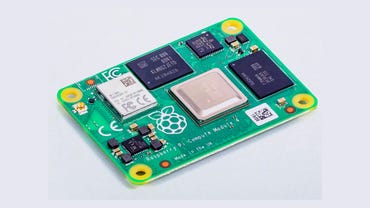
Tech specs:
- 4-Core 1.5GHz 64-bit CPU
- 8GB LPDDR4-3200 SDRAM Densities
- 2x 4K HDMI interfaces 60fps H.265 (HEVC) video
- Gigabit Ethernet PHY with IEEE 1588 support
- Single-lane PCI Express 2.0 interface
- Dual MIPI DSI display, and dual MIPI CSI-2 camera interfaces
- VideoCore VI graphics, supporting OpenGL ES 3.x
- 28 GPIO pins, with up to 6 × UART, 6 × I2C and 5 × SPI
Raspberry Pi Compute Module 4 incorporates a quad-core ARM Cortex-A72 processor, dual video output, and a wide selection of other interfaces.
Pros:
- Raspberry Pi quality
- Lot of power in a small package
- Perfect for industrial use
Cons:
- Not really aimed at home users
You can read our full review for a more in-depth look at the Raspberry Pi Compute Module 4.
What is the best Raspberry Pi alternative?
The ASUS Tinker Board S R2.0 is ZDNet’s top pick overall.
| Rapsberry Pi alternative | Price | Features |
| ASUS Tinker Board S R2.0 | $149 |
|
| Libre Computer Board AML-S905X-CC (Le Potato) | $55 |
|
| Odroid N2+ | $67 |
|
| UDOO BOLT V3 | $67 |
|
| Raspberry Pi Compute Module 4 | $35 |
|
Which is the right Raspberry Pi alternative for you?
When you are dealing with a cheap SBC, it’s a case of buying a board and getting on with the project. Buf if you are thinking about spending more money on hardware, you want to make sure that you’re not throwing money away.
I suggest starting with a clear idea of what the project is. This can be the hard part, but getting it wrong can mean getting derailed partway through the project resulting in a massive setback — costing time and money.
Then, it’s a case of doing research. How much power and performance do you need? What operating system do you need?
| Choose this SBC… | If you want… |
| ASUS Tinker Board S R2.0 | The best alternative overall. |
| UDOO BOLT V3 | High-end laptop performance for VR, AR, and AI projects, |
| Odroid N2+ | Offered in a range of hardware options |
| Libre Computer Board AML-S905X-CC (Le Potato) | A budget option for hobbyists and enthusiasts. |
| Raspberry Pi Compute Module 4 | A Raspberry Pi 4 gutted down for industrial use. |
How did we choose these Raspberry Pi alternatives?
Put simply, they all offer something that the Raspberry Pi doesn’t. The Raspberry Pi is a great bit of hardware, but it has been built within a specific set of constraints and for mass appeal. These SBCs take what the Raspberry Pi brought to the table, and take it further.
I’ve also had a chance to use all of this hardware, and they have all been tested to ascertain its quality, reliability, and whether it delivers on the promises made.
The ASUS Tinker Board S is on the list because it is the perfect choice for a hobbyist or someone who wants to learn their way around what these boards can do. It’s a nicely designed board that is aimed at making it easy to use. The board is clearly labeled and that means less time looking at a manual and more time working on projects.
Also in this list is an SBC that is better suited to harsher industrial use, which allows for projects in environments that would otherwise destroy a lesser board.
What’s the best way to get started with a single-board computer?
Get a Raspberry Pi! Get to know the setup, the GPIO pins, and work through the basics from there!
Is there a cheaper alternative to Raspberry Pi?
Not really. All the alternatives on our list cost more than the Raspberry Pi 4, which is about $35.
What’s a good source for cases?
You can find a lot of generic cases out there, but if you can drive a 3D printer, then you’ll have an endless supply of them!
Can you make your single-board computer waterproof?
You can try to waterproof the case it’s in, like spray it with a conformal coating to resist moisture. But there’s no way to make them waterproof.
[“source=zdnet”]









